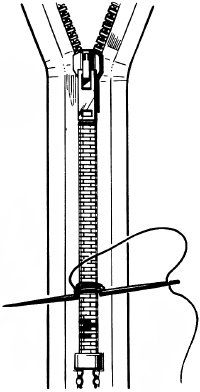How to Repair a Broken Zipper
A garment with a broken zipper is unwearable -- new or old, shabby or not. Instead of abandoning it, repair the zipper, or replace it with a new one.
Tools: needle, sewing scissors needle-nosed pliers, seam ripper, straight pins, sewing machine.
Advertisement
Materials: thread, small safety pin or paper clip, old zipper of similar size; replacement zipper, if required.
Time: 5 to 15 minutes for repair; 1/2 to 1 hour for replacement.
Before you decide to replace a zipper, examine it carefully to see if you can repair it. If a tooth is missing in the upper two-thirds of the zipper's tracks, the zipper should be replaced. If a tooth is missing near the bottom of one of the tracks, zip up the zipper so that the slider is above the damage. Thread a needle and make several stitches around both rows of teeth, just above the missing tooth, to make a new stop for the slider. Stitch over the new stop several times to make sure it's firm.
If the problem is a missing pull tab, check to see whether the slider has a hole where the pull tab was attached. If so, slip a tiny safety pin or paper clip through the hole to serve as a substitute. If there is no hole, try to salvage a clamp-on pull tab from an old zipper of a similar size; put the tab onto the slider with a needle-nosed pliers.
If the slider is off the track on a metal zipper, carefully rip out the stitching around the lower ends of the zipper tapes. Pry off the metal stop at the bottom of the zipper, being careful not to tear the tapes. Remove the zipper foot entirely.
Guide the track tapes into the grooves of the slider, inserting them into the top and pushing them through the slider to the bottom; use a pin if necessary to work the track tapes through. Pull the tapes carefully so that the slider is evenly seated on the tracks.
When both tapes have been threaded through the slider, carefully pull the slider up until the locked track teeth appear at the bottom. Make sure the slider is evenly seated on the tracks, or the zipper won't close evenly at the top. Sew a new stop at the bottom of the tracks with needle and thread, and repair the stitching that holds the zipper in the garment.
If the zipper is beyond repair, replace it with a new one of the same length. Buy a zipper in a matching color, and be sure it's the right weight and kind for the garment.
With a seam ripper, carefully remove the stitching holding the old zipper in place. As you work, note how the old zipper was put in, and in what order the various lines of stitching were made; pants zippers especially may be put in with several lines of stitching. If a waistband is involved, remove no more stitching than necessary to free the upper ends of the zipper. Remove the old zipper and pull out all loose thread ends.
Following the directions on the zipper package, pin the new zipper into place and stitch it the same way the old zipper was stitched; use a sewing machine with a zipper foot. Make the final topstitching on the outside of the garment, by hand or by machine.
A trip to the tailor or to the trash aren't your only options for ripped or torn clothing. With a few minutes of work, you can give your damaged clothes a new lease on life. Read on to learn more.
